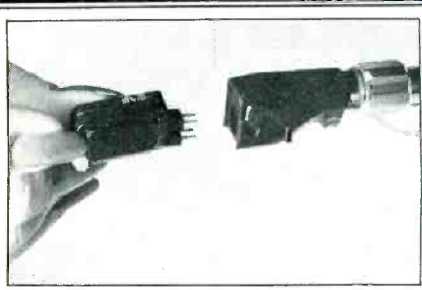Plug-In Plaudits

Shure pickup and Technics P-Mount adaptor. Goodbye, Screws and Washers? You can probably measure how long you're been reading Audio by how many tiny screws, nuts, washers, weights and spacers have accumulated from the phono cartridges you've mounted. You may not need all that hardware much longer, though.
The ideal has always been a plug-in cartridge which would snap into perfect alignment with the arm, no tools or screws or alignment gauges needed. But cartridge makers have resisted standardizing on such a mount.
At least, they did till Technics started selling rafts of linear-tracking turntables with plug-in Technics cartridges. With no other way to sell cartridges for these tables, the cartridge makers soon came up with plug-in cartridges of their own. Audio-Technica, Empire, Nagatronics, Ortofon, Pickering, Shure and Stanton are already joining the fold, and there will doubtless be others soon.
So far, only Technics turntables (including some new models with conventionally pivoted arms) and Radio Shack's new LAB-2000 linear-tracking model can use these cartridges. But, with so many cartridges available, other arm and turntable makers will probably adopt the system, too. Technics has encouraged this by giving it a generic name, "P-Mount," so other turntable makers won't have to call their products "Technics-compatible." So far, there have been no takers.
P-Mount cartridges all have the same mass (6 g), as well as the same dimensions, so you won't have to rebalance your arm if you swap cartridges. What happens when a new, lighter generation of cartridges arrives? Technics' Sid Silver doubts that will happen before digital discs take over. If it does, though, one could simply offer lower-mass arms with snap-on counterweights to handle earlier P-Mount cartridges.
My only reservation is to wonder whether the mounting system is really rigid enough. It seems to be, but we have not yet run a P-mount arm and cartridge through a formal test. To keep the system rigid, the cartridge is held in by a screw, not just snapped in place, so you'll still need a screwdriver, at least, when mounting cartridges. That's a bit more work than interchanging headshells with pre-mounted cartridges, but it also helps eliminate the headshell's mass.
Printer's Deviltry

We try to filter out the typos, and we usually succeed. But there are occasional beauties that we really wish we could leave in, for sharp-eyed readers to enjoy. For example, the typesetter's change of a "2-µF" capacitor to a "2-MF" one. That would turn a common capacitor, about the size of an infant's fingernail, into a rip-snorter the size of a 70-story building, 350 feet in diameter! Even that is based on new technology, which allows 1-F capacitors (built only for display, nobody uses them) to be a mere eight inches long by three inches in diameter. At one time, says Sprague Electric, a 1-F capacitor would have filled a small room.
Piezo Film
Piezo-electric films have been used in commercially made speakers (Pioneer's HPM tweeters, for example). If you'd like to try building your own piezo speakers, you may have trouble finding the special films and information on how to use them. Here's a source: Piezo Film Group, Pennwalt Research Chemicals, P.O. Box C, King of Prussia, Pa. 19406. Their tech data book on Kynar Piezo Film lists microphones, pickups and headphones as other possible applications. Minimum order is $35 worth, which will get you about 200 square centimeters (31 square inches) worth, in a variety of sizes and thicknesses.
Components vs. Systems?
One-brand rack systems first appeared as a merchandising ploy--regular components, matched in style, size and performance, but sold as one system rather than separately.
A rack cabinet tied the pieces together visually and kept the system compact. (The idea is neither new nor Japanese--Stromberg-Carlson had similar systems in the '50s, but with console-shaped racks.) This limited the choice of components to the ones which fit the rack (which rather pleased the buyers who'd rather not face too many choices). However, it may also have been the first step toward locking system-buyers into one brand or system. Many systems now offer unified remote controls that won't work with other brands. Some have automatic selectors, where starting the turntable automatically switches the preamp to phono, while tuning in a station switches the preamp to FM. Schneider's Direct Contact System components plug together without cables (as will Aiwa's V-1000 and a forthcoming Technics system)though you can also hook up other components using the normal jacks and cables.
These are real conveniences. But they do limit your choice. And they needn't, if the industry had chosen common control and connection interfaces. But standard interfaces would make these special features less of a competitive advantage, so don't hold your breath.
(adapted from Audio magazine, Jan. 1983)
= = = =